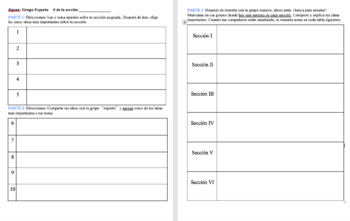Jigsaw Reading Strategy | ENGLISH & Spanish | Scaffold Reading Strategy Template
- Word Document File
Description
2 Templates. 1 is 100% in SPANISH and 1 is 100% in English to use for differentiate instruction in reading.
Jigsaw is a cooperative learning strategy that enables each student of a "home" group to specialize in one aspect of a topic (for example, one group studies habitats of rainforest animals, another group studies predators of rainforest animals). Students meet with members from other groups who are assigned the same aspect, and after mastering the material, return to the "home" group and teach the material to their group members. With this strategy, each student in the "home" group serves as a piece of the topic's puzzle and when they work together as a whole, they create the complete jigsaw puzzle.
Tips:
Differentiated instructionFor second language learners, students of varying reading skill, students with learning disabilities, and younger learners.
- Give students experience with small group learning skills before participating in the jigsaw strategy.
- Have students fill out a graphic organizer in the "home group" to gather all the information presented by each "expert."
- "Home groups" can present results to the entire class, or they may participate in some assessment activity.
- Circulate to ensure that groups are on task and managing their work well; ask groups to stop and think about how they are checking for everyone's understanding and ensuring that everyone's voice is heard; and
- Monitor the comprehension of the group members by asking questions and rephrasing information until it is clear that all group members understand the points.
______DESCRIPTION IN SPANISH_____
Jigsaw o Rompecabezas es una estrategia de aprendizaje cooperativo que permite a cada estudiante de un grupo "hogar" especializarse en un aspecto de un tema (por ejemplo, un grupo estudia los hábitats de los animales de la selva, otro grupo estudia los depredadores de los animales de la selva). Los estudiantes se reúnen con miembros de otros grupos a los que se les asigna el mismo aspecto y, después de dominar el material, regresan al grupo "de origen" y enseñan el material a los miembros de su grupo. Con esta estrategia, cada estudiante en el grupo "hogar" sirve como una pieza del rompecabezas del tema y cuando trabajan juntos como un todo, crean el rompecabezas completo.
Consejos:
Instrucción diferenciada Para estudiantes de segundo idioma, estudiantes de diferentes habilidades de lectura, estudiantes con discapacidades de aprendizaje y estudiantes más jóvenes.
- Brinde a los estudiantes experiencia con habilidades de aprendizaje en grupos pequeños antes de participar en la estrategia del rompecabezas.
- Haga que los estudiantes completen un organizador gráfico en el "grupo base" para recopilar toda la información presentada por cada "experto".
- Los "grupos en el hogar" pueden presentar resultados a toda la clase o pueden participar en alguna actividad de evaluación.
- Circule para asegurarse de que los grupos estén concentrados y gestionen bien su trabajo; pida a los grupos que se detengan y piensen en cómo verifican la comprensión de todos y se aseguran de que se escuche la voz de todos; y
- Controle la comprensión de los miembros del grupo haciendo preguntas y reformulando la información hasta que quede claro que todos los miembros del grupo comprenden los puntos.
____
I like to use this for any type of English or Spanish class where reading is required. You can break down a long text in 5 or 6 parts and have students become experts in each part OR have them read 5 or 6 short articles and share their knowledge with others.
___
Coincides with the AP Spanish Language and Culture units of:
Las familias y las comunidades
La ciencia y la tecnología
La belleza y estética
Las identidades personales y públicas
Los desafíos mundiales
La vida contemporánea
Families and communities
Science and technology
Beauty and aesthetics
Personal and public identities
Global challenges
Contemporary Life
Or newly named units:
Unit 1: Families in Different Societies
Unit 2: The Influence of Language and Culture on Identity
Unit 3: Influences of Beauty and Art
Unit 4: How Science and Technology Affect Our Lives
Unit 5: Factors That Impact the Quality of Life
Unit 6: Environmental, Political, and Societal Changes




